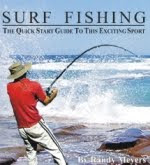There are a lot of choices a surf angler can choose from when selecting a surf fishing rod for a particular purpose. It helps if you already have some idea of the type of fishing you plan to do.
Generally speaking the length of the surf rod

will most likely be between 8' and 12'. If you don't require casting distance and plan on using it to fish in the breakers then an 8' rod should suffice.
For greater casting distance most surf anglers will settle on something between 10' and 12'.
Now I'd like to address some of the others aspects of selecting a surf rod. Fishing rods are designed around several characteristics. I won't bore you with all the technical explanations but I will cover the basics.
The basic design characteristics used are:
- Action - how much the rod bends when put under pressure
- Taper - defines the thickness of the rod & the blank
- Power - defines the strength of the rod in terms of lifting power
- Responsiveness - the ability of the entire rod to flex, the whip factor
Most surf anglers would probably want a rod with good backbone (power) to fight the more powerful fish in the surf. However, a good surf rod also needs to have sufficient responsiveness for casting greater distances. So it's a bit of a trade off.
An experienced angler will likely fish in a variety of ways and thus have several rods for different purposes. On the other hand someone just starting out would probably be perfectly happy with medium heavy, 10' - 12' surf rod. Later with more experience the new angler would add more gear to suit other needs.
In either case before selecting a surf fishing rod consider:
- How strong the rod needs to be.
- The casting distance for the length of the rod.
- The whip factor to get the casting distance needed.
One more thing before I wrap up this post. If your a freshwater angler just getting into surf fishing, you could try one of your freshwater fishing rods just to get a little experience without spending any more money on equipment. Just be aware that the surf environment is pretty harsh and freshwater equipment isn't design to stand up to the punishment.
Click this link if you want to
learn about surf fishing rods. You can find out more about it there.




